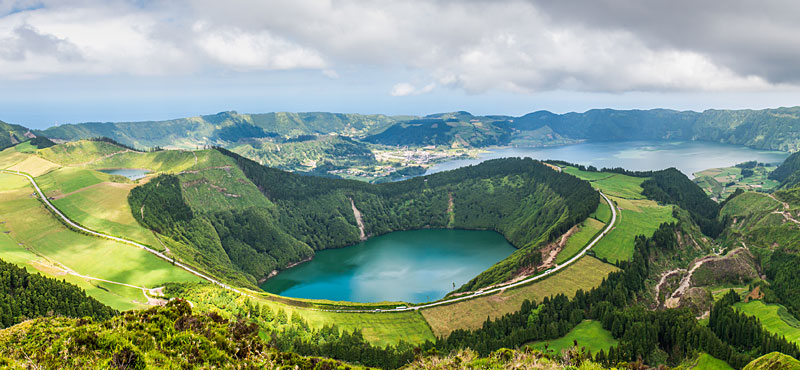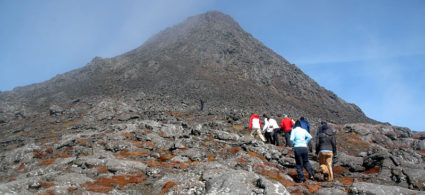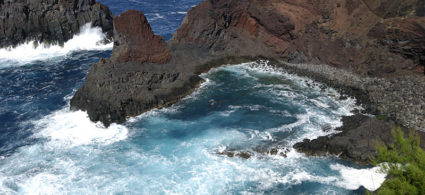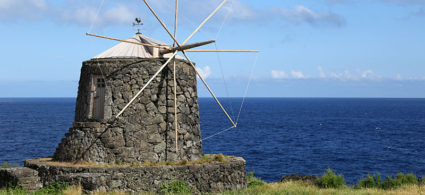

The western offshoot of Portugal, and of Europe as a whole, is located in the middle of the Atlantic: there are 16 islands of volcanic origin grouped in the two archipelagos of Madeira and the Azores; of these, 11 are inhabited and can be visited.
The Portuguese islands are completely detached from the cliché of seaside vacation islands associated with other European locations such as the Greek islands, the Balearic Islands or the closer Canary Islands.
More difficult to reach, they have not yet developed a resort-style tourism: either because of their remoteness, or because they are bathed by an ocean that does not spare waves and currents, or because of the lack of long sandy beaches perfect for the colonization by bathing establishments.
Perhaps they are not the top for sea vacations, but they are undoubtedly a wonderful destination for those who love nature, unusual destinations, the atmosphere of the ends of the world. Blessed with a spring-like climate all year round, although not always sunny, the Portuguese islands are known for their lush vegetation and varied landscapes. More than just sunbathers, they are loved by surfers and hikers.
Their beauty is rugged and wild, tourist services are little more than essential (with a few more amenities on the larger islands) and the weather largely unpredictable.
A vacation in the islands of Portugal is not easy to organize but the time spent in planning is amply rewarded by breathtaking views and unique experiences. A few examples? Spotting a whale, entering the interior of a volcano, walking through a tropical forest, bathing in natural pools and hot pools or taking a mountain vacation in the middle of the ocean. You can also admire the highest promontory in Europe and the second highest in the world (Cabo Girão, 580 m high).
The islands of Madeira and the Azores are very different from each other and it can be rightly said that each one represents a microcosm. Unfortunately, it is impossible to visit them all in a single vacation, which is why in this mini-guide to the Portuguese islands we present them one by one, dividing them into the two archipelagos.
Take a look at what to see in the Portuguese islands and you will surely find the destination that best suits the type of vacation you want to do.
Mistakenly considered an island, Madeira is actually an archipelago which includes two inhabited islands and five uninhabited islands, the latter being divided into the group of Desertas and Selvagens (Deserted and Wild). The archipelago takes its name from the biggest island, connected to Europe by direct flights.
Madeira is the most elegant of the Portuguese islands. For a long time it was synonymous with elite tourism, destination of nobles and VIPs: the most famous among these wealthy visitors was Sissi, the Empress of Austria told in the successful trilogy of romantic films starring Romy Schneider.
Today you too can experience the fairy-tale atmosphere of this marvelous island, spend dreamy days lying on the beach or walking up and down the paths crossing it and end them in beauty sipping a glass of Madeira, the fortified wine typical of the island.
In an area of about 740 square kilometers Madeira concentrates a great variety of landscapes. In some places the coast is low and sandy, in other areas of the island there are headlands of dizzying heights: Madeira is therefore an island suitable both for those who love to laze on the beach and for those who want to take an itinerant vacation in search of the most beautiful panoramic views of the ocean.
It is also a very green island, crisscrossed by paths in the middle of the forests, sometimes obtained from ancient roads or irrigation canals: a true paradise for those who love walking.
The capital of the island, Funchal, is a city full of services and accommodation; it is an ideal base for exploring the island and is recommended for those who want to combine a beach vacation and a bit of city life.
The south coast is the best choice for those who want a beach vacation in quiet places, away from the chaos, such as Jardim do Mar, Ponta do Sol and Calheta.
The north coast is the best for those who want to go trekking while the inland is an oasis of peace recommended for those who dream of absolute relaxation.
Located about 40 km northeast of Madeira, Porto Santo is a much smaller island: half an hour is enough to travel around it and it has only one important town (Vila Baleira).
The variety of landscapes and experiences that can be made compared to Madeira is certainly less, but even here tourism is very developed. The credit goes to the long sandy beach that stretches from Ponta do Calhera, at the southern end of the island, to the nautical club of Porto Santo. It is a fascinating beach of fine golden sand, 7 km long and very wide; some areas are equipped, others are free.
Although it is an island with an intimate and cosy atmosphere, Porto Santo attracts very different categories of travelers: the delightful guesthouses of Vila Baleira are perfect for a romantic vacation for couples, the few but famous discos of the island attract a young clientele while the hotels and resorts in the stretch of coast between Vila Baleira and Cabeço Da Ponta are the top for those who dream of an all inclusive vacation.
It is not possible to reach Porto Santo directly from Europe: it is necessary to take a flight from Portugal or a ferry from the island of Madeira.
More to the west of Madeira, almost halfway between Europe and America, is the archipelago of the Azores. It counts nine islands in all, divided into three groups: the westernmost islands are Flores and Corvo, the easternmost ones are São Miguel and Santa Maria, in the center are Pico, Faial, São Jorge, Terceira, Graciosa . The so called Triangle of the Azores includes Pico, Faial and São Jorge.
There are several direct flights from Europe to the Azores, but many choose to make a stopover in Lisbon or Porto; from Portugal it is possible to find several flights of low cost companies.
Once you reach the archipelago you can move from one island to another with internal flights or ferries, however the itinerary must be planned carefully; keep in mind that some flights and ferries are only seasonal.
If your vacation is only one week, it is best to focus on one island.
The largest and most developed of the Azores islands, São Miguel is also the easiest to reach and consequently the most touristy. It may be less glamorous than other islands, but it’s also the one with the most accommodations and amenities.
Also known as Green Island, it is an island with an extremely varied landscape and represents a concentration of everything that can be experienced and seen in the Azores. Calderas, hot springs, natural pools, botanical gardens, forests, natural parks and even a tea plantation: green in São Miguel takes on a thousand different shades!
The island’s top attraction are the Sete Cicades, a symbolic image of the Azores: a green-water lake and a blue-water lake separated by a bridge and surrounded by lush vegetation. They can be admired from the panoramic points that are met along a route in car or covering one of the present trekking itineraries in the zone.
The main city is Ponta Delgada, a pretty and lively town with many small shops and characteristic views.
Santa Maria is the southernmost and the oldest island of the Azores; it is also probably the sweetest island, thanks to its long beaches of golden sand and vast areas of countryside.
Its nickname is Island of the Sun, due to the warm and dry climate that differentiates it from other islands, much more humid. Because of this climate, the landscape of Santa Maria is more arid and the vegetation tends to yellow ochre instead of the bright green typical of the Azores.
Another color associated to this island is red, the color of the Barreiros of Santa Maria: they are expanses of land with a bright red color of great extension, beautiful to admire and photograph.
The capital of the island is Vila do Porto, where are concentrated the few accommodations for tourists.
The name already suggests it: Terceira is the third largest island of the Azores and was also the third to be discovered by Europeans.
The capital of the island is Angra do Heroismo, the first city developed on the archipelago and still today one of the most important. From this place, rich in history, you can leave to visit natural wonders such as the Natal cave, the hot springs of Carapacho, the fumaroles of Furnas do Enxofre or Mount Brasil.
The most famous attraction of the island, however, is theAlgar do Carvão, an extinct volcano of which you can walk through the crater. At certain times of the year the bottom of the crater becomes a sparkling lagoon.
No less interesting than Terceira’s scenic beauty is its historical and cultural heritage: you can include visits to villages, museums and wineries in your travel plans.
The most obvious choices to sleep in Sao Jorge are Angra do Heroismo if you want a city that offers many accommodations, stores, clubs and services or Praia de Vitoria if you prefer a dynamic seaside resort, suitable for young people. For a different vacation, full of relaxation and peace, give yourself a stay in a quinta in the villages of Raminho and Biscoitos.
Take a mountain vacation in the middle of the Atlantic? If this idea appeals to you go to Pico, the second largest island of the Azores.
Named after a mountain, which is also the island’s top attraction: 2350 meters high, Montanha do Pico is the highest peak not only in the archipelago but in all of Portugal, as well as one of the highest volcanoes in the world.
Experienced hikers can reach the top and enjoy spectacular views; others can take easier but no less rewarding walks inland and admire expanses of vineyards growing among the lava rocks. Don’t expect the lush greenery normally associated with the Azores islands: Pico is the most volcanic of the archipelago and lava and its distinctive feature, so much so that it is also called “Gray Island“.
The main centers of the island are Sao Roque, Madalena and Lajes.
Although the symbol of the island is an impressive caldera of which the whole perimeter can be explored, it is a reason related to the sea that brings to Faial most of the tourists.
From here, in fact, boat trips for whale watching depart: the opportunity to see these wonderful animals up close is worth the trip alone. And usually you return home satisfied, because the sighting occurs in 90% of cases.
In addition to admiring the giants of the sea, in Fajal it is also possible to snorkel with dolphins; the less adventurous can visit a museum dedicated to whalers and a pretty fishing village.
The island’s capital is Horta, but you can also stay in Varadouro or Almoxariffe.
Narrow and elongated in shape, the island of São Jorge occupies the center of the archipelago. Its distinctive feature are the fajãs, flat land by the sea created as a result of volcanic eruptions that reached the water or the landslide of earth and rock from the cliffs behind them.
There are so many (some say more than 40 and some more than 70) and many of them can be explored on foot. There are itineraries of all levels, and if you don’t feel up to undertaking them on your own, you can have a local hiking guide accompany you.
Sao Jorge is also famous for a local delicacy, which is goat cheese: a visit to the Queijo factory in San Jorge is almost a must.
To stay there are few options and in fact all visitors are based in Velas, the capital of the island.
With a name like that, which does it full justice, it is impossible not to consider Graciosa as a vacation destination. It is one of the smallest islands and is called White Island because of the presence of trachyte rocks from which it has taken a whitish coloration.
Graciosa is the island recommended to those who want to have a sea vacation in the Azores because the choice of beaches is greater than other islands and the sea is less rough.
Even here, however, the attractions that remain most in the hearts of visitors are linked to the volcanic origin of the island. Among these, not to be missed is the Caldeira da Graciosa, a volcanic cavity more than 250 meters deep and almost entirely accessible on foot. It is possible to climb to the top of the Furna do Maria Encantada or to penetrate inside the Furna do Enxfrote through a spiral staircase of 183 steps.
Santa Cruz, the island’s capital, is a quaint town full of historic buildings. Another area to consider for sleeping on the island is Praia da Graciosa, perfect if you like quiet areas with beautiful beaches nearby.
If you love wild landscapes and you don’t mind the lack of any comfort then the small island of Flores is a dream destination for you. Remote and solitary, it is the westernmost island of the Azores and represents the western end of the European continent: from here on to America there is only ocean.
Unspoiled nature and lush vegetation are the words most often used to describe it. There are those who compare it to Ireland and Switzerland for the predominance of the color green, while others consider it a corner of Hawaii in Europe for its humid climate and tropical atmosphere.
It doesn’t matter who is right, Flores will always remain in your heart for its many beauties, all to be discovered: among the dense vegetation of the island there are in fact volcanic craters (seven of them: Caldeira Branca, Caldeira Seca, Caldeira Conprida, Caldeira Negra, Caldeira Rasa, Caldeira Funda, Caldeira da Lomba), lakes, waterfalls with dizzying jumps and swollen streams of water.
The lodgings in Flores are simple, often obtained from traditional houses. The main localities are Faja Grande and Lajes Das Flores; even more traditional is the village of Cauda.
Corvo is the smallest and northernmost island of the Azores. It is an uncommon choice among tourists, but this does not mean that it is not worth coming here: life on the island is marked by a slow pace that invites idleness and enjoyment of small things, plus the beautiful landscapes are not in short supply.
In an archipelago dominated by attractions of volcanic origin, Corvo stands out for being the only volcano-island: in fact, the whole island corresponds to a single volcanic structure, the Caldeirão. For this characteristic it is called Black Island.
The Caldeirão is naturally the main attraction of Corvo: from a belvedere it is possible to admire the volcanic depression and the lake that occupies its bottom.
The only inhabited center of the island is Vila do Corvo, a characteristic town with historical black and white buildings and very narrow streets, specially created to protect from the strong winds that blow on the island.
In the following map you can see the location of the main places of interest mentioned in this article.










